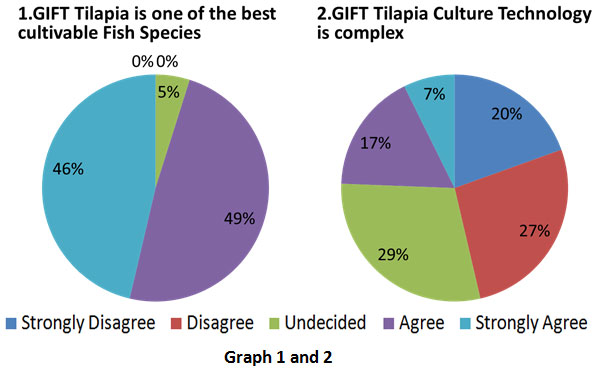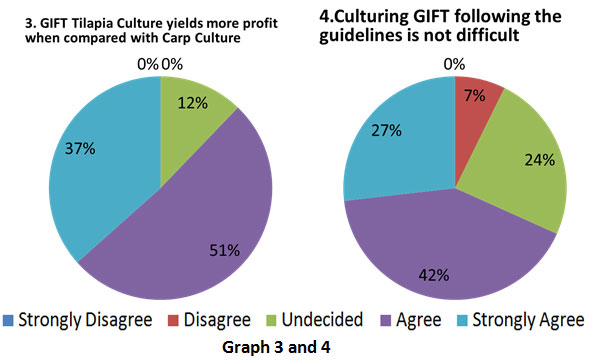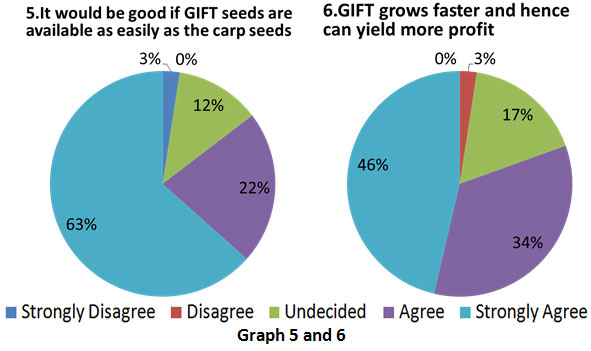Qualitative Assessment of Perception on Gift Tilapia Farming: An Analytical Perspective for Better Dissemination and Adoption
Corresponding author Email: angela@tnfu.ac.in
DOI: http://dx.doi.org/10.12944/CWE.16.1.31
Copy the following to cite this article:
Angela S. A. D, Chrispin C. L. Qualitative Assessment of Perception on Gift Tilapia Farming: An Analytical Perspective for Better Dissemination and Adoption. Curr World Environ 2021;16(1). DOI:http://dx.doi.org/10.12944/CWE.16.1.31
Copy the following to cite this URL:
Angela S. A. D, Chrispin C. L. Qualitative Assessment of Perception on Gift Tilapia Farming: An Analytical Perspective for Better Dissemination and Adoption. Curr World Environ 2021;16(1). Available From : https://bit.ly/3sNxt3s
Download article (pdf)
Citation Manager
Publish History
Select type of program for download
| Endnote EndNote format (Mac & Win) | |
| Reference Manager Ris format (Win only) | |
| Procite Ris format (Win only) | |
| Medlars Format | |
| RefWorks Format RefWorks format (Mac & Win) | |
| BibTex Format BibTex format (Mac & Win) |
Article Publishing History
| Received: | 08-04-2020 |
|---|---|
| Accepted: | 22-12-2020 |
| Reviewed by: | 
 Amulya Kumar Mohanty
Amulya Kumar Mohanty
|
| Second Review by: |

 Jayvardhan Balkhande
Jayvardhan Balkhande
|
| Final Approval by: | Dr. R. K. Aggarwal |
Introduction
GIFT has many benefits for small – scale farmers and resource poor consumers. They allow farmers a greater return on their investment and as per the WorldFish report2&3, Genetically Improved Farm Tilapia (GIFT), is one of the most farmed aquaculture fish in Bangladesh and is helping households with an income and consistent supply of fish for consumption. Africa has gained substantial socio-economic benefits by the adoption of GIFT culture technology including increased availability of low-cost high quality protein and increased employment as per the study conducted by Ansah et al, (2014)4 in their review on “Genetically – Improved Tilapia Strains in Africa: Potential Benefits and Negative Impacts”. According to this study, more work needs to be done to disseminate new strains of Tilapia such as GIFT.
However, in India compared to other tropical and sub-tropical countries, the adoption of GIFT Tilapia culture technology is only mediocre. GIFT Tilapia can play a major role in improving the aquaculture production of the country. Consequent to these, dissemination and adoption of GIFT Tilapia culture technology is a need for the aquaculture industry. Further, for both dissemination and increased adoption, it is essential to understand the perception of Fish Farmers towards GIFT Tilapia culture.
Therefore, the study attempted to analyse the perception about GIFT Tilapia Farming thereby solutions can be obtained for better dissemination and adoption. Perception is the process whereby an individual receives stimuli through the various senses and interprets them. Perception of the same situation may differ from individual to individual due to differences in their experiences and ways of looking into it5. Hence the study was conducted amongst the two categories such as Fish farmers and the Prospective Fish Farmers.
Methodology
The study was conducted in Dr.MGR Fisheries College and Research Institute, Ponneri among a selected list of people from various districts of Tamil Nadu, who are having basic knowledge about fish farming. The sample included people who are practicing fish farming / shrimp farming and who have undergone training in fish farming / shrimp farming. Forty four people who are involved in fish /shrimp farming and 38 people who have undergone training in fish farming /shrimp farming were selected for the study. Thus the total sample size is 82 (44 Fish farmers and 38 Prospective fish farmers). The term fish farmer in this study refers to the person carrying out fish or shrimp culture in ponds and the term Prospective Fish Farmer refers to those who undergone training in fish farming /shrimp farming and are about to carry out aquaculture activities. The data collection was done through focussed group discussions and structured interview schedule. Based on literature review, the interview schedule was developed with a set of statements to analyse the perception about GIFT culture. Response to each statement was scored with Likert scale from 5 to 1 for Strongly agreed, Agreed, Undecided, Disagree and Strongly disagreed respectively in order to measure the perception towards parameters such as complexity of culture, availability of seeds, marketability, preference and so on . The CPI (Cumulative Perception Index) was used to rank the statements. Percentage Analysis was used to analyse and identify the highly agreed, undecided and disagreed statements. The CPI (Cumulative perception Index) was calculated for each of the ten statements with the formula,

Where,
SA - No.of people strongly agreed
A - No.of people agreed
U - No.of people Undecided
D - No.of people disagreedSD - No.of people strongly disagreed
The higher the value of CPI, the higher is the degree of agreement to the particular statement and the cumulative Perception Index (CPI) was used to rank the statements.
Results and Discussion
 |
Graph 1 and 2: |
 |
Graph 3 and 4: Click here to view Graph |
 |
Graph 5 and 6: Click here to view Graph |
 |
Graph 7 and 8: Click here to view Graph |
 |
Graph 9 and 10: Click here to view Graph |
From the results, the two highly agreed statements are:1.GIFT Tilapia is one of the best cultivable Fish Species and 3. GIFT Tilapia Culture yields more profit when compared with Carp Culture. This indicates that the farmers and prospective farmers are aware that GIFT Tilapia is a candidate species for aquaculture. The two highly undecided statements are: 9.Marketing of GIFT Tilapia is easy and 10.For faster growth of GIFT excess feed should be given. And the highly disagreed statements include: 2.GIFT Tilapia Culture Technology is complex 10.For faster growth of GIFT excess feed should be given and 9.Marketing of GIFT Tilapia is easy. This shows that though the fish farmers and prospective fish farmers are aware of the GIFT tilapia culture, they are still not confident about the culture technologies and marketing strategies.
According to Gupta and Acosta (2014)6, the important constraints to commercial farming of Tilapia, are the scarcity of fry production and the inadequate consideration given to marketing and other business aspects. Fisheries extension efforts are obligatory for proper understanding of the technology practices, further dissemination and implementation. Availability of quality feed and seed at reasonable price needs to be ensured for the efficient extension activities of tilapia production7. Credit facilities, proper training and suitable extension services could play a significant role in minimizing constraints in tilapia farming as per the study on “Understanding the constraints and its related factors in tilapia (Oreochromis sp.) fish culture at farm level: A case from Bangladesh” by Mohammed N. U. et al (2020)8.
Table 1: Ranking of the Statements Based on the CPI
|
CPI (Fish Farmers) |
Statement |
Rank |
Statement |
CPI(Prospective Fish Farmers) |
|
2.46 |
It would be good if GIFT seeds are available as easily as the carp seeds |
1 |
GIFT Tilapia is one of the best cultivable Fish Species |
2.00 |
|
2.41 |
GIFT Tilapia is one of the best cultivable Fish Species |
2 |
Shorter period of culture is the best feature of GIFT |
2.00 |
|
2.34 |
GIFT Tilapia Culture yields more profit when compared with Carp Culture |
3 |
It would be good if GIFT seeds are available as easily as the carp seeds |
1.98 |
|
2.29 |
GIFT grows faster and hence can yield more profit |
4 |
GIFT grows faster and hence can yield more profit |
1.95 |
|
2.24 |
Shorter period of culture is the best feature of GIFT |
5 |
GIFT Tilapia Culture yields more profit when compared with Carp Culture |
1.90 |
|
2.15 |
People of inland districts only are the prospective consumers of GIFT |
6 |
Culturing GIFT following the guidelines is not difficult |
1.80 |
|
2.07 |
Culturing GIFT following the guidelines is not difficult |
7 |
Marketing of GIFT Tilapia is easy |
1.54 |
|
1.93 |
For Faster growth of GIFT excess feed should be given |
8 |
People of inland districts only are the prospective consumers of GIFT |
1.51 |
|
1.61 |
Marketing of GIFT Tilapia is easy |
9 |
For Faster growth of GIFT excess feed should be given |
1.41 |
|
1.49 |
GIFT Tilapia Culture Technology is complex |
10 |
GIFT Tilapia Culture Technology is complex |
1.17 |
Conclusion
From the results and discussions it can be suggested that for the fish farmers category, making seeds available, clarifying on the guidelines and suggesting strategies for marketing through customised and specific extension services would increase the dissemination and adoption of GIFT tilapia culture whereas for the prospective fish farmers category, providing the technical information through training and support is the key and would help increased adoption. Ferdouse (2001)9 claimed that in the well off urban markets in the south-east Asian region such as Thailand, Hong Kong, Singapore and Malaysia, house hold consumption of Tilapia can be raised by means of retail outlets such as supermarkets through supply of high quality fish which is farmed in good conditions and without any foul or muddy odour and also through the supply of Ready to cook food such as skinless fillets. Supplying live Tilapia to hotels and major markets is another marketing approach. Extension Efforts have to be concentrated on promoting such innovative marketing strategies so as to improve the adoption of GIFT Tilapia culture technology among fish farmers as well as prospective fish farmers. Capacity building, entrepreneurship development and skill development programmes on GIFT Tilapia Culture technology and Marketing strategies have to be conducted by the pertinent Institutes for increasing the adoption of GIFT culture technology in the state. In short, incessant availability of GIFT seeds, innovative marketing strategies and commodity specialised extension approach (Axinn G.H, 1988)10 are the key for better adoption of GIFT Tilapia farming technology.
Acknowledgments
The author would like to thank Tamil Nadu Dr.J Jayalalithaa Fisheries University for granting the University Research Project. The author is also profoundly grateful to Dr.K.Ravaneswaran, Professor for his guidance
Conflict of Interest
Authors do not have any conflict of interest.
- Agnes Daney Angela conducted the study and article writing
- Lloyd Chrispin article was associated in the study
Reference
- https://mpeda.gov.in/MPEDA/tilapia.php#
- https://www.worldfishcenter.org/pages/gift/
- https://www.worldfishcenter.org/content/genetically-improved-farmed-tilapia-gift-dissemination-bangladesh (2015)
- Ansah Y.B, Frimpong E.A and Hallerman E. M, Genetically-Improved Tilapia Strains in Africa: Potential Benefits and Negative Impacts, Sustainability, 2014, 6(3697-3721); doi:10.3390/su6063697; ISSN 2071-1050.
CrossRef - Kollat D.T, Blackwell R.D, Engel J.F. The current status of consumer behavior research: Developments during the 1968-1972 period. ACR Special Volumes. 1972.
- Gupta M.V, Acosta B.O. A review of global tilapia farming practices. Aquaculture Asia. 2004: IX (1). 7-16
- Alam M.F, Khan M.A, Huq A.A. Technical efficiency in tilapia farming of Bangladesh: a stochastic frontier production approach. Aquaculture International. 2012 : 20(4):619-34.
CrossRef - Mohammed N.U et al., Understanding the constraints and its related factors in tilapia (Oreochromis sp.) fish culture at farm level: A case from Bangladesh. Aquaculture. 2020: 530(735927) https://doi.org/10.1016/j.aquaculture.2020.735927.
CrossRef - Ferdouse F. Tilapia in Asian markets-can we sell more?. Infofish International. 2001:23-6.
- Axinn G.H, Guide on Alternative Extension Approaches, FAO. Rome. 1988. 148 pp. http://www.fao.org/3/ac991e/AC991E03.html






